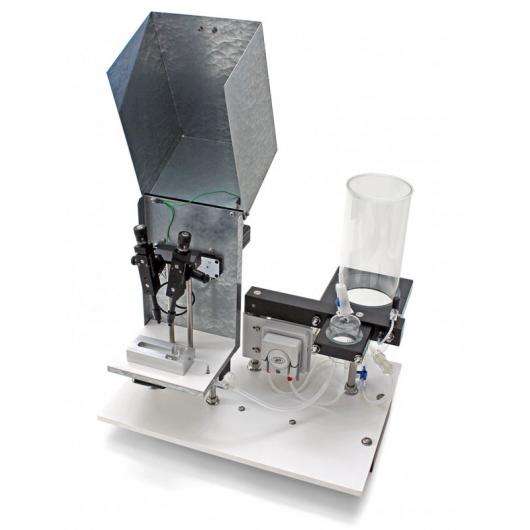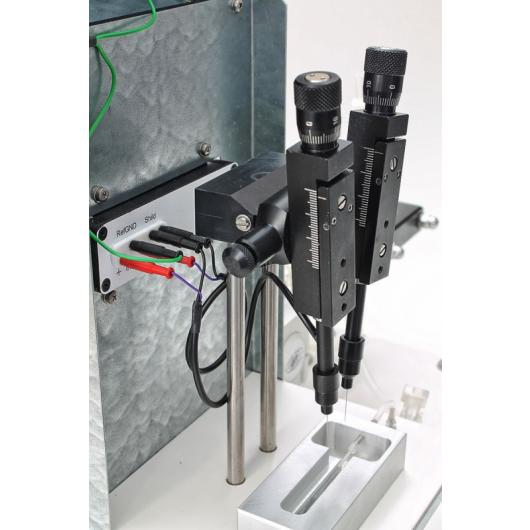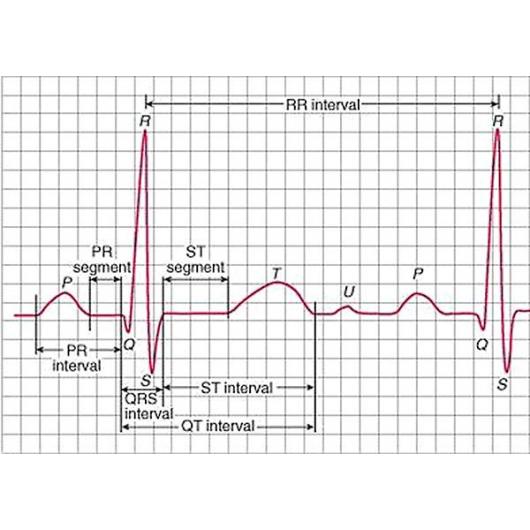




CardioFish system
A highly integrated workstation, designed and developed by MDE Heidelberg is suitable for the measurement of spontaneous or affected cardiac responses on adult (at least 3 months old) species. The mechanics, the sensor the low-noise broadband amplifier and the data displaying, storaging and analyzing software form a harmonious unit in the system.
The design of the measuring unit was based on the fact that ion channels defining the operation of the heart show partial similarity between human and zebrafish. This mechanism results in a nearly similar monophasic potential (MAP) measurement to the human ECG.
System includes three main units
- Mechanical unit
- Low-noise broadband analogue amplifier
- Data visualization, - archiving and –evaluation hardware/software
The vibration-free object table is holding the two main units of the system (the micromanipulators and the broadband amplifier). The Faraday cage encloses this ensemble and carries the broadband amplifier on its backside. It ensures complete shielding from electrical and magnetic fields interference. Attached to the table are the fish tub and the two micromanipulators. The micromanipulators can easily be adjusted horizontally and bear removable electrode-holders that can accept either our stainless-steel premanufactured electrodes, or user-designed electrodes or a standard holder for glass electrodes.
ECG recording
For ECG recordings both the quickbuttons above the monitoring filed and the roll down orders of the menu can be applied. The applied filter visualization or the appearing visual parameters of the ECG curve can be altered (eg.: amplification, speed), the notes belonging to the measurements can be recorded, respectively the recording process can be started or stopped.
Signal display can be adjusted by setting the width of the time window and amplification display factor. The optimisation of filter effects (50 or 60 Hz notch filter, high-pass baseline filter (removing breath-related baseline oscillations) and low-pass high frequency rejection filter) is aided by visualizing superimposed raw and filtered signals. User can place time labels with comments along the recording session, making it easier to retrieve sections of interest for off-line analysis.
Offline evaluation
The recorded ECG signal can be either evaluated right after the measurements or at any time later. The software provides five different possibilities for so doing.
The most typical ECG parameters can be quickly calculated, as well as more complex features however, owing to the wide choice of analysis routines included.
1. One cursor analysis: can be applied to collect the amplitudes, at user defined cursor position on the ECG signal, and HR values are collected into a chart.
2. ECG normal analysis: evaluating the ECG with automatic parameter measurements, from any single optional cycle chosen by the user.
3. ECG averaged analysis: a user defined number of continues ECG cycles can be synchronized and averaged, allowing extraction of low amplitude features. Automatic parameter measurements can be done on any user defined time region of the averaged signal.
the user.
4. ECG QT analysis: calculating an eligible QT or QTc value, as well as QT variability (QTv) as a function of RR or HR, in case of at least 32 chosen cycles.
5. Heart rate variability (HRV) analysis: The analysis of the variation of heart frequency with time and frequency domain analysis, RR normalization is also provided.
- Persistent ECG monitoring with heart frequency display
- A.C. network noise-filtering algorithm (50/60Hz notch filter)
- Muscle movement (vibration, tremor) filtering algorithm
- Sampling frequency: 1000 samples/sec/channel
- Amplification: 10000x
- Input resistance: 10 MΩ symmetric
- Output resistance: 50 Ω
- Output Voltage Range: ±5V 2kHz
- MECHANICAL PARAMETERS
- Overall dimension: 400 x 300 x 350 [mm]
- Manipulators 0,05 mm /revolution/25 mm course
- Size of fish bath:20 ml
- Overall dimensions of fish bath: 90 x 40 x 20 [mm]
- Material of fish bath: anodized aluminium
France, Lyon
- ISERM, EA 4612 Neurocardiology, Physiopathology of the disorders of the heart rhythm; Georges Christé, PhD
Hungary, Gödöllő
- Szent Istvan University, Department of Aquaculture; Béla Urbányi, PhD





